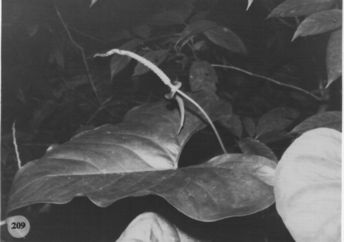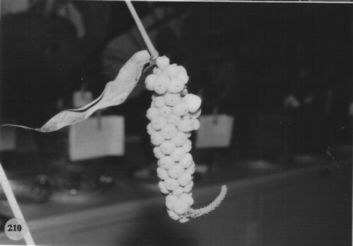



Anthurium umbrosum Liebm.,
Vidensk. Meddel. Dansk Naturhist. Foren. Kjobenhavn 1:21. 1849. TYPE:
Mexico. Oaxaca: near Mirador, Uebmann 15790 (C, holoTYPE: F, US,
isotypes).
Anthurium liebmannii Schott, Bonplandia7:
165. 1859. TYPE: Mexico. Oaxaca: near Teolalcingo, 5.000', Liebmann (C).
Terrestrial to 1 m tall; stems 2.5-3 cm diam.; internodes very short; leaf
scars to 2 cm wide; roots few, moderately thin, descending; cataphylls
coriaceous, sometimes tinged with purple, 5-9 cm long, emarginate and long-apiculate
at apex, drying dark tan (B & K Yellow 6/7.5), weathering into longitudinal
fibers and persisting.
LEAVES with petioles arching, subterete, sometimes narrowly and
bluntly sulcate, or weakly flattened adaxially, 12-46 cm long; geniculum
0.7-1.1 cm long; blades medium thick, narrowly ovate to ovate-triangular,
gradually long-acuminate at apex, deeply lobed at base, 20-43 cm long,
12-27 cm wide, broadest at base or midway between base and point of petiole
attachment, the margin broadly undulate; anterior lobe 15-32 cm long, margin
broadly convex, posterior lobes 4-14.5 cm long; sinus hippocrepiform to
spathulate or parabolic, rounded to acute at apex; both surfaces semiglossy;
the midrib convexly raised above, raised and conspicuously more acute below;
basal veins 4-6 pairs, prom-inulous above, and below, third to sixth coalesced
2-3.5 cm, posterior rib straight to weakly curved, almost completely naked,
the outer margin turned conspicuously upward; primary lateral veins 3-5
per side, departing midrib at ca. 50° angle, straight to weakly arching
to collective vein, sunken above, flat to prominulous below: lesser veins
visible, ± flat above and below; collective vein arising from the
first basal vein, sunken above, raised below, 8-12 mm from the margin.
INFLORESCENCE usually longer than leaves, spreading to pendent;
peduncle 25-84 cm long, 2.5-3.5 mm diam., terete, at least twice as long
as petioles; spathe coriaceous, green, sometimes tinged with violet-purple,
oblong-lanceolate to narrowly ovate-triangular, 5.5-13 cm long, 1.5-3.3
cm wide, gradually long-acuminate at apex, narrowly inrolled to 2.5 cm
long, rounded to subcordate at base, inserted at 45°-60° angle
on peduncle; spadix green turning dark violet-purple to brownish at anthesis,
4.8-12.2 cm long, 5-12 mm diam. at base, 3-6 mm diam. at apex; flowers
rhombic to sub-4-lobed, 3.3-4.1 mm in both directions, the sides straight
to gradually to jaggedly sigmoid; 6-7 flowers visible in the principal
spiral, 6-8 flowers visible in the alternate spiral; tepals matte, weakly
punctate, minutely papillate with scattered droplets, lateral tepals 2-2.5
mm wide, the inner margins broadly convex; pistils green, weakly exsertedjust
before anthesis; stigma elliptic, conspicuously raised, large stigma drop
apparent shortly before stamens emerge; stamens emerging from base in a
regular pattern, the laterals first, soon followed by alternates, complete
in basal one quarter before the laterals emerge just above midway; anthers
cream, held in noncontiguous circle around pistil, ca. 1 mm long, 1-1.1
mm wide; thecae ovoid, slightly divaricate; pollen cream.
INFRUCTESCENCE spreading to pendent; the spathe persistent; spadix
11-13 cm long, 1.7-2 cm diam., berries usually developing in basal one
half to two thirds;berries bright orange, ± globose, usually with
4 radial ridges, the apex broadly rounded to nearly truncate; mesocarp
juicy, somewhat pulpy, orange with numerous raphide cells; seeds 2, obovoid,
6-7.5 mm long, 4.5-6 mm wide, 3-4 mm thick, depressed at apex. Figs. 209
and 210.
Anthurium umbrosum is endemic to Mexico and known only from northern
Oaxaca, principally in ihe Sierra de Juarez, south ofValle Na-cional on
the Atlantic slope at 1,200 to 1,800 m elevation. It occurs in wet cloud
forests on usually steep slopes. The species is characterized by its terrestrial
habit, moderately thick, usually narrowly ovate, long-acuminate leaf blades,
green, coriaceous, lanceolate spathe, which curls under along margins,
spadix green in early stages, becoming vi-olel-purple, and orange, 4-ridged
berries. Anthurium umbrosum is in section Belolonchium
and is closely related to A. Iancetillense.
It is distinguished from that species in having shorter, more flexible
peduncles, longer, more pendent inflorescences, somewhat smaller, distinctively
4-ridged berries, and a thicker spathe. Anthurium umbrosum occurs
at much higher elevations, A. Iancetillense having been collected
only in the Lancetilla Valley in Honduras at elevations of 10 to 600 m.The
species is also similar to A. ovandense from
southern Oaxaca and Chiapas, but that species has a much thinner blade
that 15 minulely
Anthurium umbrosum is also similar to A. lezamae from
northern Oaxaca, but that species differs in having a minutely alveolate
epidermal pattern (at least on drying).
Map of Mesoamerican specimens with coordinates
Mexico Oaxaca: Cerro Concordia, 800-1000 m,, , Morton & Makrinius
2727 (K).
Mexico Oaxaca: 1220 m,, 22 Aug. 1977, Thomas B. Croat 43905 (K, MO).
Mexico Oaxaca: 1210 m,, 30 June 1977, Thomas B. Croat 39787 (K, MO).
Mexico Oaxaca: 625-785 m, 17.44N 96.19W, 2 February 1987, Thomas B.
Croat and Dylan P. Hannon 65535 (MO).
Mexico Oaxaca:, , Waimea 80p441 (MO). Mexico Oaxaca:, , Thomas B. Croat
74120 (MO).
Mexico Oaxaca:, 22 Nov. 1984, Martínez S., E. et al. 8773 (MEXU).
Mexico Oaxaca: Mpio. Comaltepec, 1600 m, 17.37N 96.21W, 8 July 1990,
Luna , R.L. & G.J. Martín 655 (MEXU).
Mexico Oaxaca: 660 m, 17.44N 96.19W, 26 August 1996, Thomas B. Croat
78706 (CM, MO).
Mexico Oaxaca: 1020 m, 17.39N 39.96W, 22 February 1988, Rafael Torres
C. con L. Cortes A. 11590 (MEXU, MO).
Mexico Veracruz:, , Liebmann 15790 (C).





